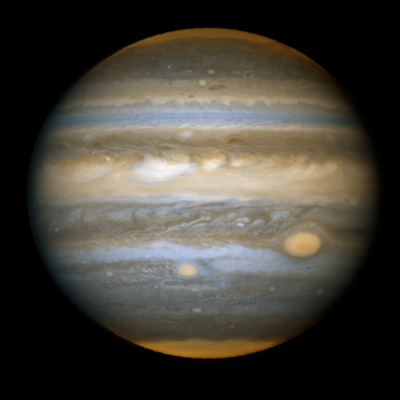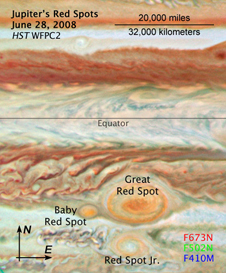
by Carolyn Gramling Thursday, January 5, 2012

Jupiter's Great Red Spot (right) has been noted since astronomers first trained their telescopes on the skies 300 years ago. In February 2006, it was joined by Red Spot Jr. (bottom center). NASA, ESA, A. Simon-Miller (Goddard Space Flight Center), I. de Pater, M. Wong (UC Berkeley)

As of 2008, there are three red spots on Jupiter's face: the Great Red Spot, Baby Red Spot (left) and Red Spot Jr. (bottom). NASA, ESA, A. Simon-Miller (Goddard Space Flight Center), N. Chanover (New Mexico State University) and G. Orton (Jet Propulsion Laboratory)
Like any aging planet, Jupiter’s face has undergone a few changes over time. And even as the gas giant’s most famous feature — the colossal storm known as the Great Red Spot — appears to be shrinking, other spots have appeared.
Measurements of the wind velocity of these storms, taken between 1996 and 2006, show that the more than 300-year-old Great Red Spot is getting smaller, according to a study presented in November at a meeting of the American Physical Society. By analyzing both wind speeds and directions, a team led by fluid dynamicist Xylar Asay-Davis of the University of California at Berkeley determined that the size of the Great Red Spot (originally about twice the diameter of Earth) shrank by about 15 percent over those 10 years, although the storm itself is not slowing down.
Meanwhile, in 2000, a new storm appeared alongside the Great Red Spot. The fledgling storm, the product of a merger between three white, oval-shaped storms between 1998 and 2000, was initially white, and about half the size of the Great Red Spot. But by early 2006, Red Spot Junior had turned the same red color as the original spot, likely an indication that the new storm is intensifying, the scientists said. And things are getting messier: In 2008, a third storm emerged in Jupiter’s turbulent atmosphere.
Why Jupiter’s storms are changing isn’t yet clear. But the shift in storms may reflect a changing climate on Jupiter, the scientists said: The south pole may be getting colder and the equator warmer, and the new vortices — which can transport heat around the planet — may be Jupiter’s way of adjusting to the climate change.
© 2008-2021. All rights reserved. Any copying, redistribution or retransmission of any of the contents of this service without the expressed written permission of the American Geosciences Institute is expressly prohibited. Click here for all copyright requests.